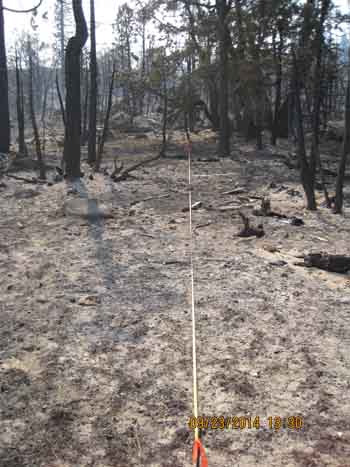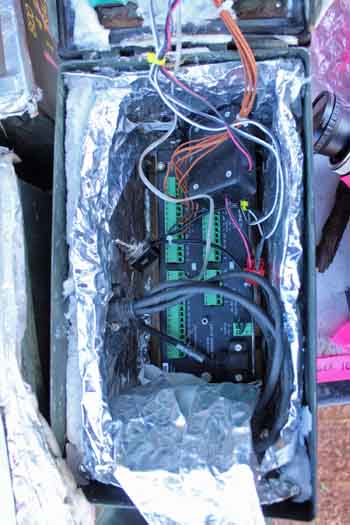(Note from Bill: A Fire Behavior Assessment Team (FBAT) has been studying the King Fire east of Placerville, California. Rae Brooks, an Information Officer at the fire, sent us this article describing what a FBAT does.)
****
These scientists set up equipment in front of a fire to collect fire behavior data
by Rae Brooks
FORESTHILL, Calif. — Fire scientists call them “plots.” Dotted ahead of the leading edge of the King Fire, they were deliberately placed in the anticipated path of the flaming front. Each plot contained a video camera, wind-speed gauge and other monitoring devices.
If the flames came, a data logger buried a foot underground would collect information that would allow the scientists to better understand the science of wildfire, gauge the effectiveness of fuel treatments, and contribute to firefighter safety.
So while thousands of firefighters were building line, clearing brush from roads and bulldozing contingency lines to suppress the King Fire, the scientists patiently waited for flames to sweep over their plots, if control efforts failed.
“We want our plots to burn,” said Carol Ewell, co-lead of the FBAT, or Fire Behavior Assessment Team, at the King Fire. “Firefighters put the fire out. It’s a difficult balance.”


Mark Courson, a division-qualified firefighter and an operations section trainee, served as operations lead for the FBAT at the King Fire. His job was to keep the team safe and advise on site selection.
“Usually I’m thinking of putting the fire out,” said Courson. “Now I’m bucking the system, thinking where suppression might not hold it.”
The team, a U.S. Forest Service module, draws members from around the country to work 14-day assignments on wildfires. Since 2006, the FBAT has recorded data at 16 wildfires, including last year’s Rim Fire, the third largest in California history. Generally, emerging fires with potential for growth suit the FBAT better.
At the King Fire, just three of 10 sites selected burned over. The team averages 50 percent, but sometimes gets lucky and finds all its plots burned.
“It’s a big gamble,” said Ewell. “Our success rate is quite variable, and I’m not sure that’s a hurdle that we can fix.”
The King Fire was particularly difficult to read after it made a speedy 15-mile run northward beginning late in the afternoon of Sept. 17, Ewell said. Rain has since quelled the fire, which is now 89 percent contained.
Despite the inherent difficulties, free-burning wildfires provide conditions that cannot be replicated in laboratory, experimental or prescribed fires. For instance, no prescribed fire would ever be set during California’s current historic drought. The team has recorded active crown-fire runs, fire whirls, spot-fire ignitions, and merger of spot fires with the main flame front.
The team’s prime mission at the King Fire is to study the effectiveness of fuel treatments. Team members set up plots in treated and nearby untreated areas to provide comparisons.
Because they are working ahead of the flaming front, they follow standard firefighting safety protocols, carefully considering whether they can get safely into and out of selected sites. “Unburned fuel between you and the fire,” is one of the 18 Firefighting Watch Out Situations, and, by necessity, their equipment must be placed in unburned fuel ahead of the fire.
“There is risk involved,” said team member Matt Dickinson, an ecologist at the Delaware, Ohio, location of the Forest Services’s Northern Research Station. “One way we mitigate is to set up plots early in the day before the peak burning period. We pull out quite often when we’re not feeling comfortable.”
It takes about an hour for nine FBAT members to install their gear and inventory the vegetation at each site. If firefighters are trying to build line and the team is trying to set up a plot, the firefighters, of course, have priority, said Ewell. “In comparison, we’re just a geek squad,” she said, although most FBAT members are experienced firefighters.

At each plot, the team sets up temperature sensors, heat flux sensors, anemometers to measure wind speed, and video cameras encased in heat-resistant steel boxes. The cameras start when trigger wires are burned over. Each camera captures about 80 minutes of footage.
The flames often melt the anemometer’s plastic cups, so wind speeds might only be collected before flames arrive. At each site, team members also bury a data logger in a military surplus ammunition box. Other members collect information about the vegetation, down to counting sticks on the ground.
At the King Fire, the team also recorded fuel moisture data to help fire behavior analysts working on the fire.
In the future, Ewell would like to equip the team with more heat-flux sensors, Go-Pro video cameras with new triggers, and anemometers that can better withstand heat. The team relies on grant money and project funding from the Forest Service to continue its work.
When sites burn over, team members return, when it is safe, to collect their equipment and the data. They also record how the vegetation has fared. Plots that don’t burn are permanently marked with rebar, so they can provide fuels information for other uses.
The team spends evenings entering data and crunching numbers, and tries to complete a summary report before demobilizing from a fire.
Seeing a wildfire burn during severe drought has been an eye-opener, said Dickinson. Most of his experience has been with prescribed fires. He found the tremendous consumption of fuels and the severe damage to trees hard to witness.
William Borovicka, who normally works at the Vinton Furnace State Experimental Forest in McArthur, Ohio, was a first-time FBAT member at the King Fire. Back home, he studies how oak and hickory forests, if left undisturbed, convert to beech and maple woods. His work in Ohio, he feels, plays into management techniques to stabilize the oaks and hickories.
Using FBAT findings to gain a deeper understanding of fire behavior might similarly help forest managers someday with decision-making, Borovicka said.
“Maybe more prescribed fires, or different harvesting techniques,” he said. “Whatever it takes to prevent this kind of blow-up.”

Great to see fire research taking place in the woods, so much is done with computer modeling and existing data anymore. Nice to see data get collected the old fashion way, with data loggers, cameras, instruments and people.
Fascinating. Good for USFS to seize the opportunity to gain knowledge and information and good for the professional and apparently fearless team to do the tough prep work and imaginative research and to find balance among perspectives as they communicate their findings. One can only imagine the heartbreak of watching 500 year old trees burn to the ground.
Very important and interesting work, I hope your “success” rate for burned plots is better next time. Great to hear the perspective of folks from the East.
very interesting – thanks!
Jen